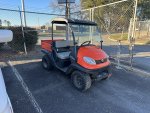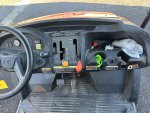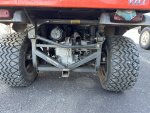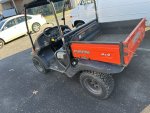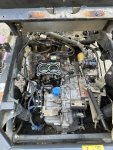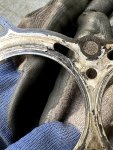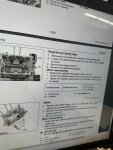Good afternoon, new member to the forum. I'm in the throws of repairing a 2010 RTV 500 I purchased and I thought it might be helpful (for myself and others) if I posted about my "journey".
I bought this machine from a public school auction. Had a good battery and turned over ok but wouldn't start. I believe I got a fair deal and assumed there was potentially something major wrong with it because I paid about 1/5 of what it looks worth. It has 1400 hours on the clock.
Got it home and started trouble shooting. Pulled the spark plugs and did a compression test. 190# on each cylinder...promising. I was lead to believe it likely had a blown head gasket by the staff at the location I picked it up from. Checked for spark, put some gas in it, turned it over and it stumbled, tried as best it could to start, unsuccessfully.
It was around this time I twisted the coolant cap off, because I couldn't think of anything else to do at that moment. High pressure shower of coolant is what happened next. Darn. I guess it does have a bad head gasket.
So...this engine is really strange to me. I've worked on plenty of small engines but never a Kubota gasoline engine. This should be good, I'm definitely going to learn a lot on this one.
In the interest of continuity, Ill advise that Im now putting it back together. It was the last "setback" I experienced which convinced me to post as much as I can remember here for future shade-tree mechanics like me.
I bought this machine from a public school auction. Had a good battery and turned over ok but wouldn't start. I believe I got a fair deal and assumed there was potentially something major wrong with it because I paid about 1/5 of what it looks worth. It has 1400 hours on the clock.
Got it home and started trouble shooting. Pulled the spark plugs and did a compression test. 190# on each cylinder...promising. I was lead to believe it likely had a blown head gasket by the staff at the location I picked it up from. Checked for spark, put some gas in it, turned it over and it stumbled, tried as best it could to start, unsuccessfully.
It was around this time I twisted the coolant cap off, because I couldn't think of anything else to do at that moment. High pressure shower of coolant is what happened next. Darn. I guess it does have a bad head gasket.
So...this engine is really strange to me. I've worked on plenty of small engines but never a Kubota gasoline engine. This should be good, I'm definitely going to learn a lot on this one.
In the interest of continuity, Ill advise that Im now putting it back together. It was the last "setback" I experienced which convinced me to post as much as I can remember here for future shade-tree mechanics like me.
Attachments
-
1.1 MB Views: 30
-
665.1 KB Views: 33
-
908.9 KB Views: 34
-
876.1 KB Views: 30


